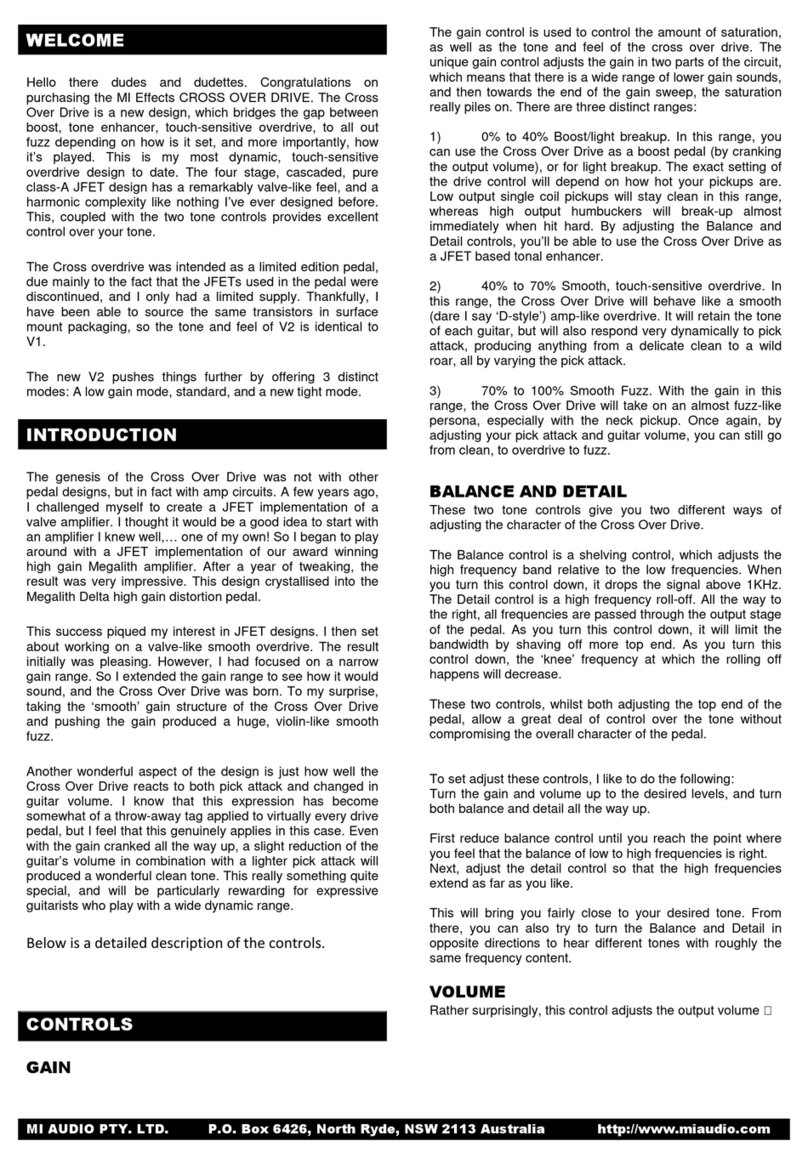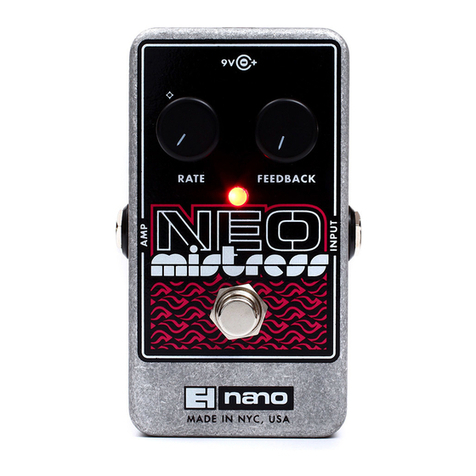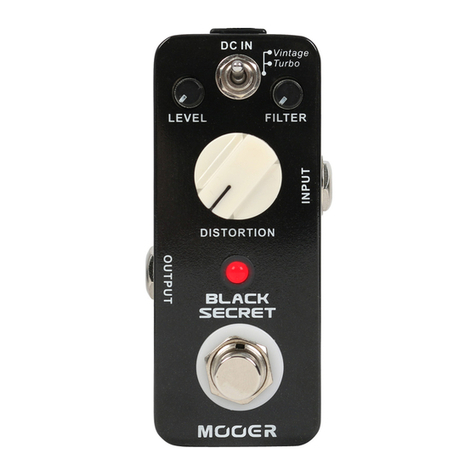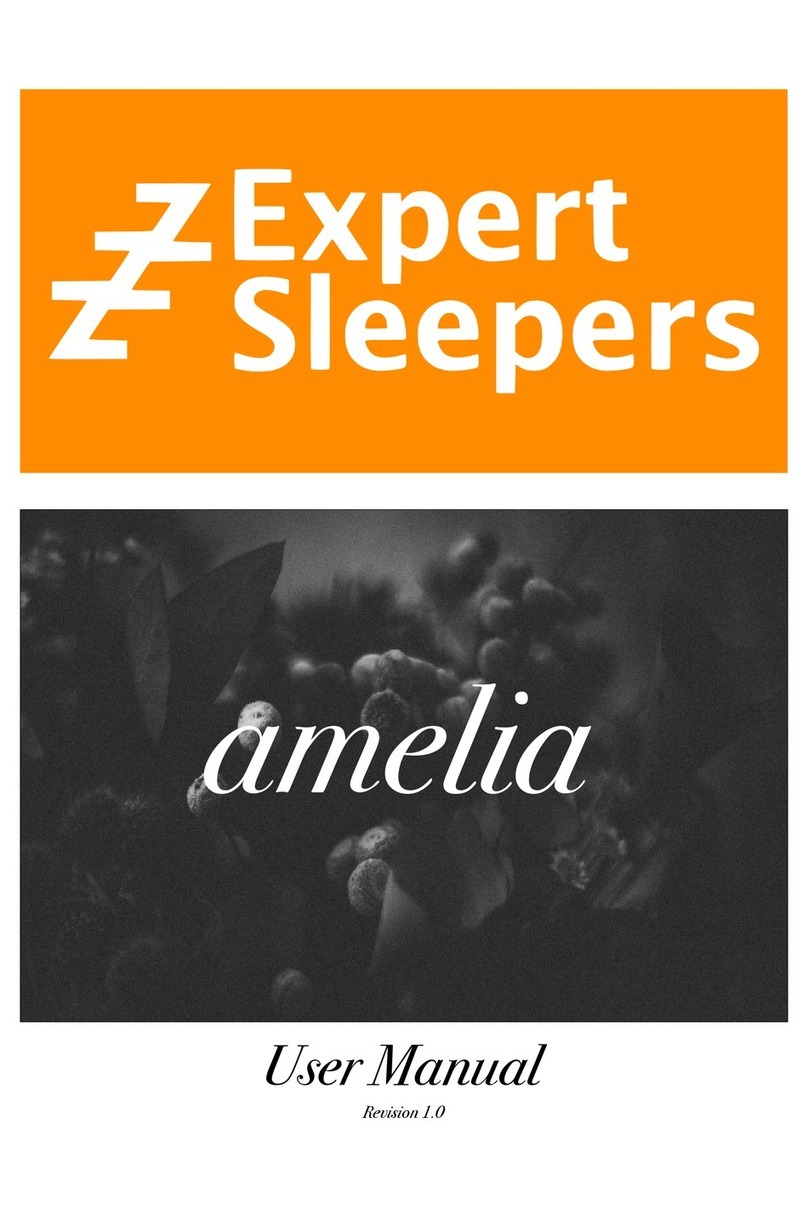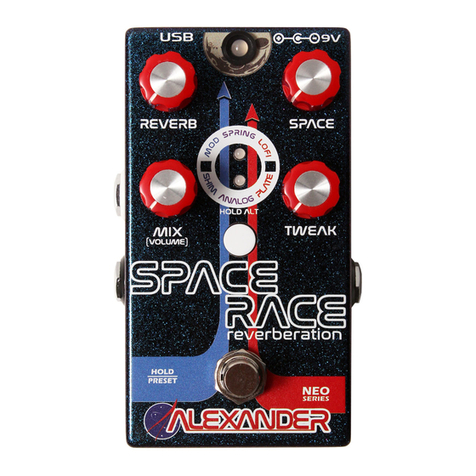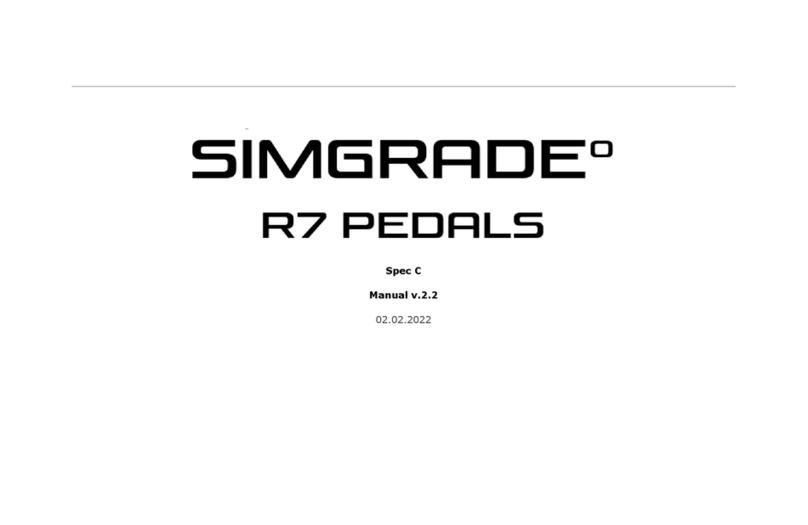MI Effects Boost 'N' Buff Installation guide

MI AUDIO PTY. LTD. P.O. Box 6426, North Ryde, NSW 2113 Australia http://www.mieffects.com
INTRODUCTION
G’Day! Congratulations on purchasing the MI Effects Boost
‘n’ Buff v.3 pedal. This is one of our favourite and most
popular pedals in the MI family, which has had a facelift with
the new version.
We asked you, the users of the Boost ‘n’ Buff, what would
you want in a boost pedal and we aimed to deliver with more
headroom, more clarity, and more versatility with a three-way
boost mode and an operating voltage of ~24V! The Boost ’n’
Buff is a multi-purpose tool that should be on all guitarist’s
pedal boards and is now on yours!
FEATURES
HEADROOM!!
Like most guitar tools, the Boost ‘n’ Buff is a pedal that
always sounds best at its highest operating voltage. The
previous version ran off 9V supply, or 18V with the use of
two batteries. This newest version of the Boost ‘n’ Buff
features some internal circuit wizardry that takes 9V ONLY
(refer to POWERING THE PEDAL section) by DC adaptor or
battery and internally supplies the pedal with approximately
24V! This means no more dual batteries, or additional 18V
power supplies. Put 9V in, and enjoy the extra clarity, sparkle
and headroom of the Boost mode.
BUFFER MODE (BYPASS)
In bypass mode, the Boost 'n' Buff acts as an ultra high input
impedance/low noise buffer. In fact, the input impedance is
approximately 5Meg. With such a high input impedance, your
guitar pickups don't need to deliver a lot of current in order to
reproduce their full natural bandwidth. You can drive cable
lengths as long as you like without sacrificing tone, and due
to the ultra low noise design, you can use the Boost 'n' Buff
out the front of dirt pedals or high gain amps without worrying
about introducing any significant noise.
So what's different about this buffer and the buffer you'd find
on mass produced pedals? Well, the primary role of a buffer
on a mass produced pedal is not to 'rescue' your guitar tone
from degradation, but rather to drive the low quality transistor
based switching system. The input impedance of these
buffer circuits are thus designed not to keep all of the top end
sparkle of your guitar tone. In some cases, the input
impedance of this buffer is as low as 200kOhms, which is 25
times lower than the input impedance of the Boost 'n' Buff
circuit.
By adding the Boost 'n' Buff in your signal chain, especially
near the front of your effects, you'll notice that in bypass
mode your guitar signal will have a bit more sparkle and top
end detail. It's not that there are any special EQing 'tricks',
but rather that the Boost 'n' Buff is faithfully reproducing all of
the frequencies that are coming out of your guitar. Your tone
will feel a bit more powerful, with more punch and almost as
if there's more dynamic range and 'sustain' (although these
are not the right words to describe it). You've got to try it out
to feel what I'm talking about.
BOOST MODE
FULL BOOST –This is a full frequency boost regardless of
the gain and volume settings. It not only boosts the volume,
but seems to really lift your tone as well. It’s difficult to
explain. You’ve just got to feel it. This is perfect for solo
volume boosts. The one thing to note is that if you're going to
use digital effects in your signal path, I'd suggest putting the
Boost 'n' Buff after the digital effects to avoid overloading the
A/D converters.
TREBLE BOOST –I tuned this mode to be a more of a
dramatic treble boost than the stock Boost ‘n’ Buff. I figured
that if the full boost option is now available, then it would be
possible to make the treble function a bit more prominent. At
maximum gain, not only do you have an amazing amount of
boost (approximately 35db), but the frequency response is
perfectly tailored to driving a valve amp. It is literally like hot-
rodding your amp with an extra tube stage. Also, with the
24V headroom, your sound will be 'cleaner' going into the
amp, so that there's less colouring from the transistor.
MID BOOST –This came about because I quite liked how
the treble boost pushed an already overdriven amp, but for
some amps, I found that too much top end made the tone too
harsh (For others it was fine). So by rolling off some of the
highest frequencies, and beefing up the mids, we were able
to get the extra gain, cut and richness, but without the ice-
pick.
VOLUME AND GAIN CONTROL
Turn down the volume, and use the built in gain of the Boost
'n' Buff to get mild dirt sounds, boosting different parts of the
frequency spectrum with the MODE switch. Finally, by mixing
the relative levels of volume and gain, you can now coax a
wider range of timbres from the pedal.
N.B. THE GAIN POT WILL CRACKLE!!!
Like the mixing desks of old, this transistor boost design has
DC across the gain pot causing a crackling sound when
moved –an expected part of the design and one that
shouldn’t cause much grief as it tends to be set-and-forget.

MI AUDIO PTY. LTD. P.O. Box 6426, North Ryde, NSW 2113 Australia http://www.mieffects.com
TIP: Another interesting application is using the Boost 'n' Buff
in the FX loop of an amp to act as a secondary volume
control. Since it has ample headroom, line level signals are
not a problem. So even if your FX loop is line level, you can
still get quite a bit of boost using the Boost 'n' Buff. This way,
your FX loops can also double as a solo volume booster as
well as a standard FX loop. By putting the Boost 'n' Buff in
the FX loop, you can use it to boost the volume of an
overdrive channel. If you're using the overdrive channel of
your amp, then putting any booster between the guitar and
amp will just increase the amount of distortion as opposed to
increasing volume. By putting it AFTER the preamp (in the
FX loop), you can achieve volume boosting without affecting
preamp tone.
POWERING THE PEDAL
PLEASE READ CAREFULLY!!!
THE BOOST ‘N’ BUFF VERSION 3 PEDAL RUNS
OFF 9V ONLY. REPEAT. ONLY USE A 9V BATTERY
OR 9V DC POWER ADAPTOR.
The Boost ‘n’ Buff v.3 is designed for 9v, and will not run
better at higher voltages (for technical reasons). In fact you
can cause damage to the circuit if a higher voltage is applied.
The 9 volt DC port (which accepts a standard barrel jack with
a Negative centre pin.) or 9V battery may be used. If using
battery to power the new Boost ‘n’ Buff, and the pedal begins
to sound different, please monitor the voltage of the battery
with a multimeter and/or replace the battery with a new one.
If using a battery, the pedal is powered when a plug is
inserted into the input jack. So when not in use, disconnect
the input plug to maximise battery life.
To access the battery, unscrew the 4 screws at the bottom of
the pedal and remove the bottom plate.
REGISTRATION & WARRANTY
To register your pedal, you can email your name, contact
details, purchase date, and retailer details along with the
Alternatively, you can send the above information to the
postal address on the front of this manual. PLEASE
REGISTER YOUR PEDAL. In the long run, it will be difficult
to have your pedal serviced if you need to if the pedal is not
registered.
This pedal carries a 5 year warranty that covers all repairs
due to manufacturer error. It does not cover any damage due
to user mishandling, shipping, acts of God, and abuse. The
owner should contact MI Audio directly for all repairs, and
any work done by anyone other than MI Audio voids the
warranty. All shipping costs are the responsibility of the
owner, and are to be paid in advance of any work performed
on the pedal. The owner may be asked to provide a copy of
the sales receipt for verification.
DISCLAIMER
The owner or user assumes responsibility for death, injury
and/or damages relating to the operation of this device. MI
audio assumes no responsibility for death, injury or damages
relating from the operation of this device. I am always
thinking of ways to improve things, so all specifications are
subject to change without notice.
Other MI Effects Music Pedal manuals
Popular Music Pedal manuals by other brands
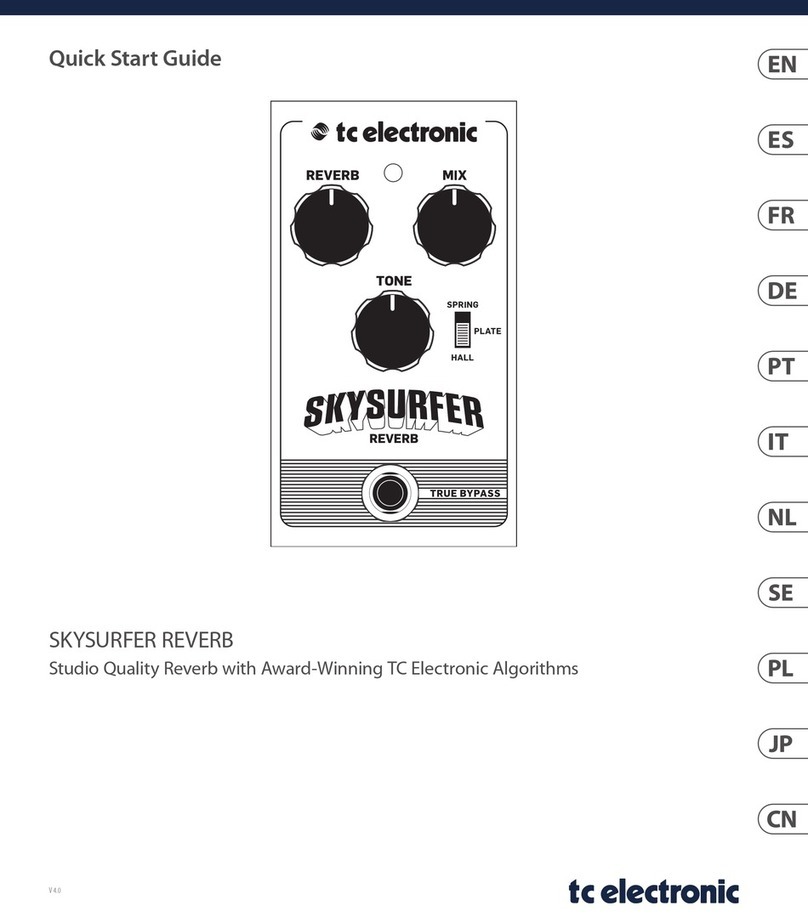
TC Electronic
TC Electronic SKYSURFER REVERB quick start guide
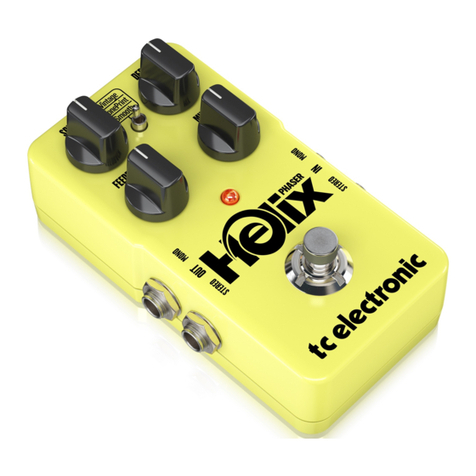
TC Electronic
TC Electronic Helix Phaser user manual
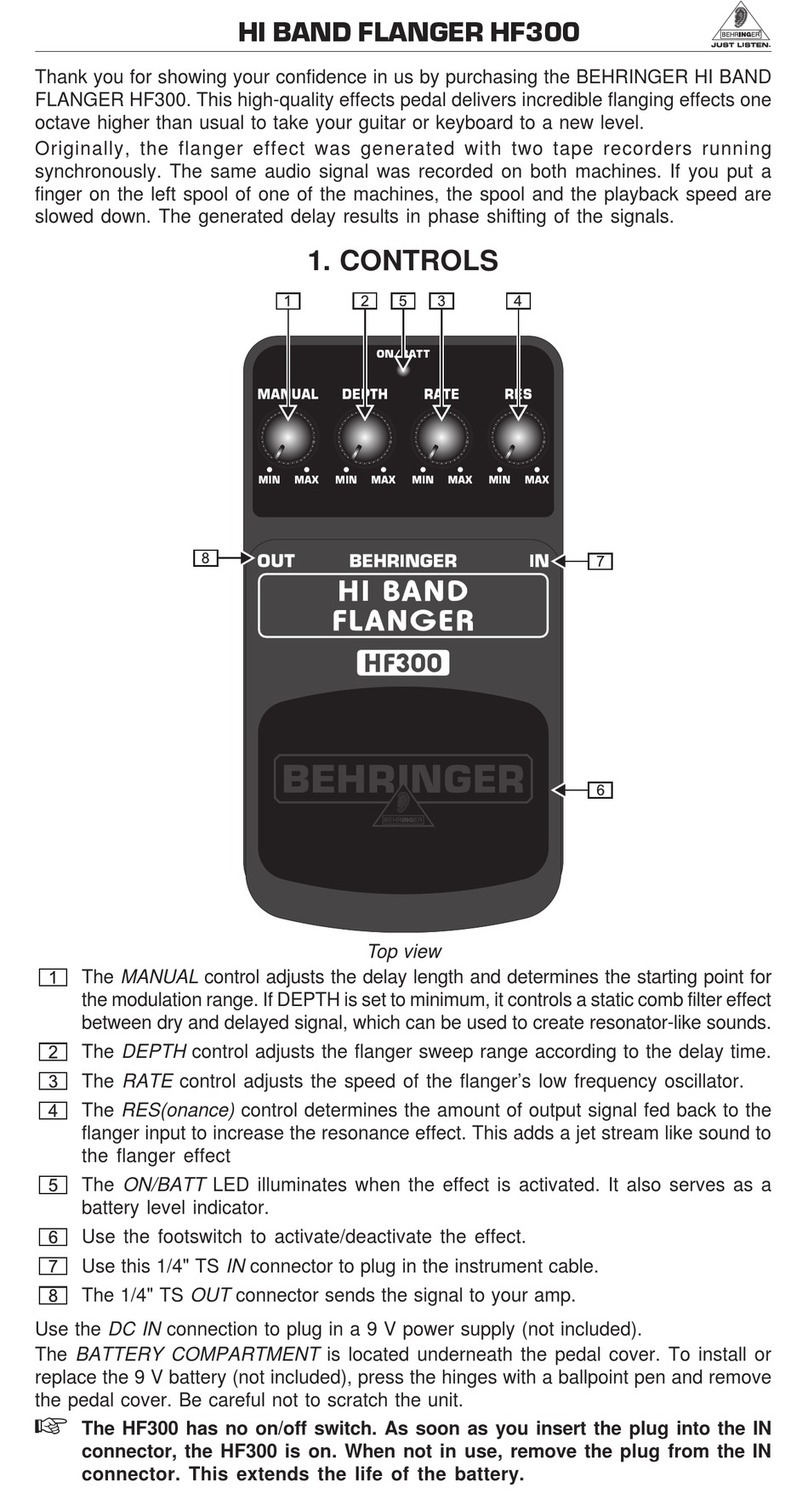
Behringer
Behringer HI BAND FLANGER HF300 user guide
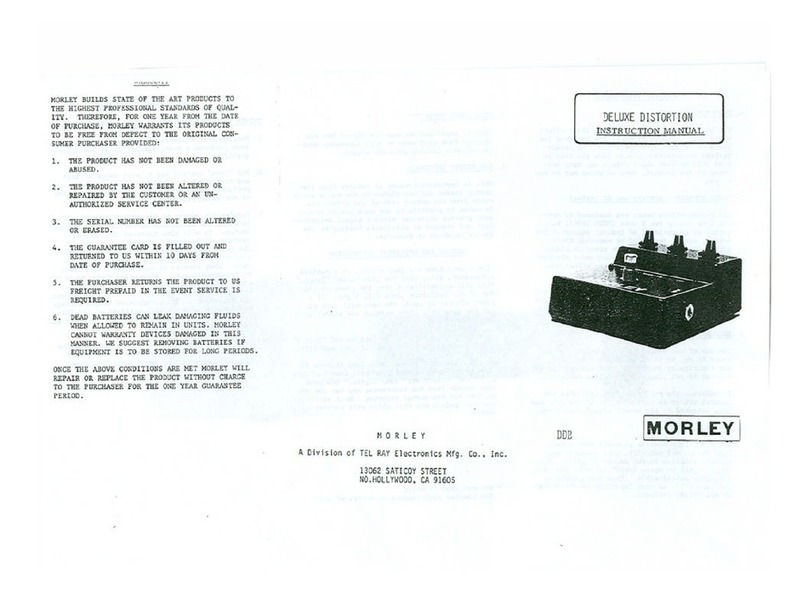
MORLEY
MORLEY DDB1 instruction manual

Lithium Grim
Lithium Grim Dirty Little JCM Building instructions

Vein-Tap
Vein-Tap Dark Arts Tap Tempo Phaser instruction manual
